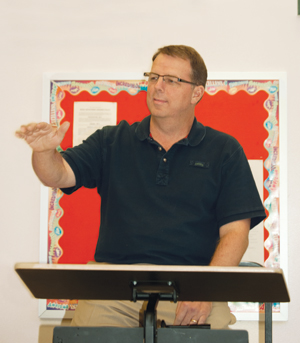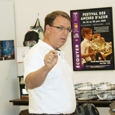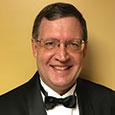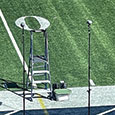 Scott Casagrande of Hersey High School in Arlington Heights, Illinois produces top concert and marching bands by combining a staff of 20 private teachers to give lessons at the school each week. He places a heavy emphasis on the fundamentals of excellent playing. Participation in the marching band is mandatory, and as with many schools, the marching band plays the same program throughout the fall. What is unusual is that the band always marches to arrangements of classical works. This year the selections will be excerpts from Tchaikovsky’s 4th and 5th Symphonies.
Scott Casagrande of Hersey High School in Arlington Heights, Illinois produces top concert and marching bands by combining a staff of 20 private teachers to give lessons at the school each week. He places a heavy emphasis on the fundamentals of excellent playing. Participation in the marching band is mandatory, and as with many schools, the marching band plays the same program throughout the fall. What is unusual is that the band always marches to arrangements of classical works. This year the selections will be excerpts from Tchaikovsky’s 4th and 5th Symphonies.
What do you consider to be the keys to the success of your band?
One is the group of 20 individuals I chose as part-time private teachers. Because the school is fairly close to Chicago, I can pick from a large pool of qualified musicians. Everyone in the top band takes private lessons either at school or on their own as do about 75% of the students in the second band. I have come to realize that one of my most important jobs is determining which teachers to select and how much to control them. I want them to teach with a philosophy that is consistent with my own.
After an extensive interview, the individuals I select go through a background check and fingerprinting, and sometimes I will watch as they give a practice lesson to a student. I particularly look for private teachers who played in a high school program that was similar to what we have at Hersey High School because they automatically understand what I expect of students and what to teach for them to reach these goals. The fact that we offer private lessons is a big selling point with parents and students. In some instances I have made poor choices of private teachers and have asked them to leave. The money for outside staff comes from the band boosters and with a little from the school.
How do you hold students accountable for performing at an advanced level?
Our school district is crazy about testing, and students deal with the pressures of this quite well. All testing with the top group is done through a commercially available computer program. With this program students learn notes and rhythms much faster than before, and we can move on to the more important elements during rehearsals. Students are tested in one way or another throughout the year, but the first formal round begins in December. The test is on the music that will be on the February concert program, as is the second round of tests in of January. There are also tests in March and mid-April on the material for the April and May concerts.
Students who attain a score of 85% on the first try earn an A. Everyone else has to repeat the test; if they pass the grade will be a B. Every repeat test lowers the grade one notch. They keep at it until they pass. I have no idea whether other directors use tests this way, and this was not my original idea. I got the idea of do-overs from my father.
For many years he tested by listening to tape recordings students prepared and submitted together with a copy of the music. As he listened to each tape, he father circled the measure whenever he heard a mistake, whether it was a wrong note, rhythm, or dynamic. This took a tremendous amount of time, but it did establish when each student made mistakes, often without realizing it. With a computer program the testing takes much less of the director’s time, but the concept is the same. Students know right away when they make a mistake on a note or rhythm. One negative is that they get no feedback on dynamics and other elements of a good performance. Overall, I attribute a great deal of our success to frequent testing and holding students accountable for making progress throughout the year.
Because so much of the work in music occurs when students practice on their own, how much time do you spend teaching them how to practice?
At the beginning of the year and several times later on, I devote most of a rehearsal to explaining how students should practice at home. I may ask a student to come up and play a difficult passage for the class, after which the other students critique what they heard and offer suggestions on how to improve it. It is easier for students analyze someone else’s problems because then they merely listen and aren’t distracted by their own mistakes and problems.
Unless I teach students how to practice in class, I have found that most will run through the music several times without stopping, even after making a mistake. What they should do is stop to analyze the source of the mistake, then work through the passage very slowly and correct it. Only when they can play it perfectly several times should they begin to pick up the tempo. Once they have the notes right, the most common mistakes are in the rhythms and intonation.
As an example, with the Tchaikovsky excerpts with the marching band this year, there are many bunches of 16th notes that seem to have no pattern at all. The details I explain include how to tongue and train the fingers to be rhythmic. In sectionals we will break down a sixteen bar run of 16th notes into the phrases within the sixteen bars. I want to teach students to internalize the phrasing and set them up for what they should practice at home.
Early in the year we also focus on playing with a good sound and intonation by using simple chorales. Later in the year we will to devote more attention to playing in the proper style and phrasings. At this point I will often play a recording by an advanced band to instill in students the sound we want to achieve. Recordings are a big part of the process.
How do you plan the rehearsal time to prepare for a concert?
We are fortunate to have a class schedule that places the top two bands consecutively in the middle of the day. This means that students rehearse one period and have lunch in the other while the other band eats and then plays. This makes a switch from one band to the other very easy, and students may move both up and down during the year. This keeps students on their toes, and it is possible to have combined marching rehearsals early in the year. Another benefit is that those students who play sports (about 60% of the band does) have no afterschool conflict with band. I take considerable pride in the fact that so many band students go out for at least one sport because it adds a breadth of experience from different activities into the rehearsal room.
We spend a great deal of rehearsal time on fundamentals and warm-ups. Early in band camp we spend an entire rehearsal playing fundamentals and on the basics of marching. This begins with extensive breathing exercises. Students put a hand in front of the mouth and inhale for eight counts and blow out over four. A variant of this to inhale for eight counts and blow out over eight counts. From there we moved on to four counts in and out, then twos, then ones. Students get dizzy after all this so we rest a bit. Through this process they certainly learn what it means to move a lot of air.
Next we apply the concept of moving air to a series of four notes up the scale. After a few weeks of this I will shift the focus to playing with good tone and intonation over an increasingly wide range of notes. The concept of moving lots of air is a natural lead-in to working on intonation and good tone. We start out with a note in the middle of the range and pop up to a higher note, focusing on tone and intonation. From there the brass move into a series of lip slur exercises.
In some warm-ups the brass play lip-slurs while the woodwinds play chromatic runs at the same tempo. The result is that the woodwinds work on playing alternative fingerings rhythmically while the brass build flexible chops. We may move into pure intonation work by matching the tones of others. I may have students hold one note until it is in tune, then go on to the next note. This is a slow process early in the season, but it pays dividends later.
How have you approached learning the marching show this fall?
We introduce students to the music in several June rehearsals and asked that they be able to play it by the first August rehearsal. Theoretically we should not have to spend much time learning notes and rhythms and can go right into the nuances and the drill.
Another band had these Tchaikovsky excerpts arranged, so we bought the rights to reuse this arrangement for a lot less than the first school paid. We will also play the beginning of the pizzicato movement as a percussion feature. I have a talented front percussion line this year, and about ten of them will play some really serious 16th note passages.
 I really like this arrangement, and students find it is fun to play. I believe that Hersey High School is a bit unusual in that the marching band introduces students to great music. With younger bands most schools lean more toward educational music, but I feel that we should take every opportunity to expose even the younger players to fine music. It drives me crazy to see schools that waste all the time they spend on marching band on crummy music.
I really like this arrangement, and students find it is fun to play. I believe that Hersey High School is a bit unusual in that the marching band introduces students to great music. With younger bands most schools lean more toward educational music, but I feel that we should take every opportunity to expose even the younger players to fine music. It drives me crazy to see schools that waste all the time they spend on marching band on crummy music.
Too many directors look past the classics, but I believe the reason this music has lasted so long is that it is truly great. For me there is nothing cooler than watching students who have never heard classical music before decide that they like it. I know this will happen with the Tchaikovsky show this year. After all, isn’t this our job?
How much do you include sightreading in rehearsals?
The top concert band will sightread 15-20 pieces of music a year, but the jazz band reads 30-40 charts a year and performs 10-15 of them. Those players in the jazz band have fewer problems with rhythms, syncopation, and subdivision in concert band music after learning these in jazz.
About 75% of the way to a concert, I will focus intently on playing right notes, rhythms, and style. At this stage we start working in sectionals and testing students with computer programs to elevate their playing to the next level. We will work on rhythms they can’t get right on their own and strive for a consistent ground, especially in the extreme ranges. Students respond well to the pressure because they do not want to embarrass themselves in front of their peers.
I try to keep the December holiday concert fun and the music easy after the tough and laborious marching season. As the same time we prepare this holiday concert, I will choose music for the February concert, which will be significantly harder. We also showcase the chamber ensembles as every player in the top band plays in a small ensemble at the holiday concert along with many students in the second ensemble. By the end of February we work on the toughest music of the year in preparation for the our application to Superstate, which is a wonderful opportunity for students to play on the same stage as some of the greatest bands in Illinois. The audition tape is due at the end of February. Starting in the middle of April we begin working on the spring concert, which is much lighter and highlights seniors who have made it to the all-state band.
How has being a parent of student musicians changed your approach over the years?
My views on teaching music have evolved because of my experiences as a dad and watching my children progress through lessons. My daughter has had a progression of different piano teachers. One spent a crazy amount of time on a single piece when my daughter was seven or eight. She felt so discouraged that she wanted to quit piano and move away.
When we switched teachers, she ended up with a teacher who didn’t spend much time polishing the music. As a result my daughter had a poor experience and never reached a higher level of performance on any piece. The instructor was always rushing on to the next piece. The third private teacher takes a middle ground on perfecting the music. Close to a performance the focus is on making the music sound as good as possible, but otherwise she will play through a wide range of music.
I really believe there is a proper balance between the two extremes and try to employ a similar philosophy with my ensembles. With our lighter concerts during the year, we read through much more literature. My bands will read a ton of music at the beginning and end of the year, but during the middle of the year we work hard to reach the next level of performance.
I am always amazed at how quickly we move through literature for the end of the year concert, after having worked on harder music earlier in the year. That last concert comes together very quickly and sounds almost as good as those we spent so much time on earlier in the year. Having learned the process of problem-solving, students become better players. Near the end of the year when we throw all kind of music at students, they apply everything that they have learned. Overall, I hope the process stretches them to learn how to tackle a difficult problem and allow them to play some great music.





